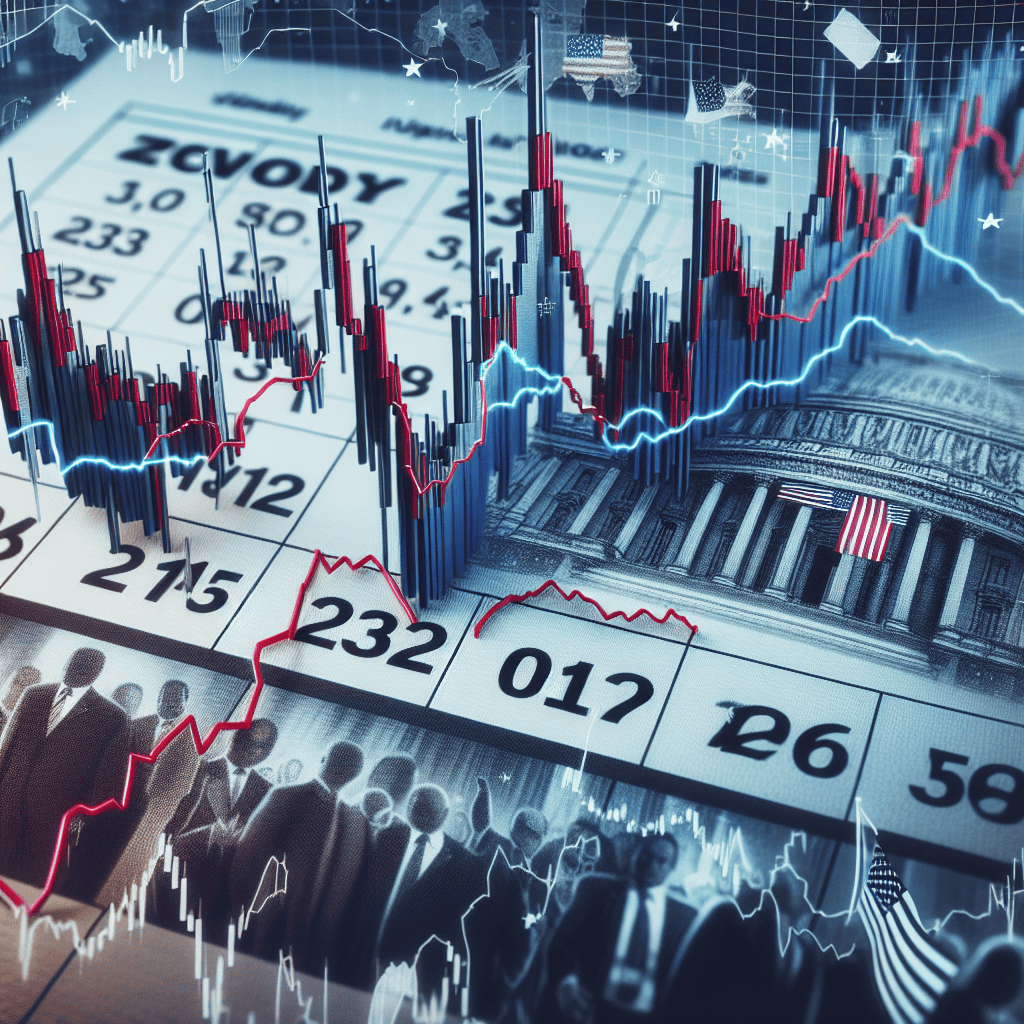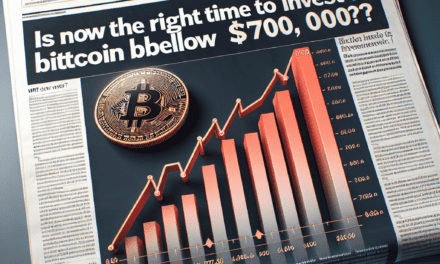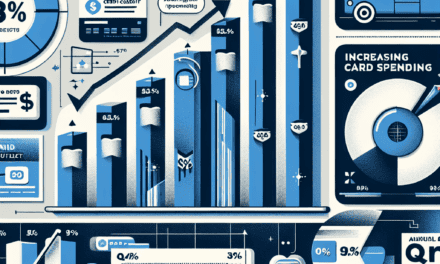“Markets Waver as Election Looms: Uncertainty Casts a Shadow on Indices”
Introduction
As the presidential election looms on the horizon, market indices are experiencing a notable decline, reflecting the heightened uncertainty and volatility that often accompany such pivotal political events. Investors are closely monitoring the evolving political landscape, as the outcome of the election could significantly influence economic policies, regulatory frameworks, and international relations. This period of anticipation and speculation is marked by fluctuating stock prices, shifts in investor sentiment, and strategic repositioning within portfolios. The interplay between political developments and market dynamics underscores the intricate relationship between governance and economic performance, highlighting the critical role of elections in shaping the financial landscape.
Impact Of Presidential Elections On Market Indices
As the presidential election approaches, market indices have begun to exhibit a noticeable decline, a phenomenon that is not entirely unexpected given historical trends. The relationship between political events and financial markets is complex, yet the anticipation of a new administration often brings a degree of uncertainty that can influence investor behavior. This uncertainty is primarily driven by potential shifts in economic policy, regulatory changes, and fiscal strategies that a new president might implement. Consequently, investors tend to adopt a cautious stance, leading to fluctuations in market indices.
Historically, the period leading up to a presidential election is marked by increased volatility in the stock market. Investors, wary of the unknown, often reassess their portfolios, leading to a sell-off in equities. This behavior is compounded by the media’s intense focus on the election, which can amplify concerns about future economic policies. As a result, market indices such as the Dow Jones Industrial Average, the S&P 500, and the NASDAQ Composite often experience a downturn as election day nears. This trend is not solely attributed to domestic factors; global investors also keep a keen eye on U.S. elections, given the country’s significant influence on the world economy.
Moreover, the impact of presidential elections on market indices is not uniform and can vary depending on the candidates’ perceived economic agendas. For instance, a candidate advocating for increased government spending and higher taxes might be viewed unfavorably by investors who prefer a more laissez-faire approach. Conversely, a candidate promising deregulation and tax cuts might be seen as more market-friendly, potentially mitigating some of the negative impacts on market indices. However, it is essential to note that these perceptions are often speculative and can change rapidly as more information becomes available.
In addition to the candidates’ economic policies, other factors contribute to market volatility during election periods. The potential for contested election results, for example, can exacerbate market uncertainty. In such scenarios, the lack of a clear winner can lead to prolonged periods of market instability as investors grapple with the implications of a delayed transition of power. Furthermore, geopolitical considerations, such as international trade relations and foreign policy stances, also play a crucial role in shaping investor sentiment during election times.
Despite the short-term volatility associated with presidential elections, it is important to recognize that markets tend to stabilize once the election outcome is clear and the new administration’s policies become more defined. Historically, market indices have shown resilience, often rebounding in the months following an election as investors gain clarity and confidence in the new government’s direction. This pattern underscores the importance of maintaining a long-term perspective when navigating the financial markets during election periods.
In conclusion, while the approach of a presidential election can lead to a decline in market indices due to heightened uncertainty and investor caution, it is a temporary phase that typically resolves as the political landscape becomes clearer. Investors are advised to remain informed and consider the broader economic context when making investment decisions during this time. By understanding the historical patterns and potential implications of election outcomes, investors can better navigate the challenges and opportunities that arise in the lead-up to a presidential election.
Historical Trends: Market Indices During Election Years
As the presidential election approaches, market indices often exhibit a pattern of volatility, reflecting the uncertainty and anticipation that characterize these pivotal moments in American political life. Historically, election years have been marked by fluctuations in market performance, driven by investor sentiment and the potential for policy changes that accompany a new administration. Understanding these historical trends provides valuable insights into how markets might behave as the current election draws near.
To begin with, it is essential to recognize that market indices, such as the Dow Jones Industrial Average, the S&P 500, and the NASDAQ, serve as barometers of investor confidence and economic health. During election years, these indices are particularly sensitive to political developments, as investors attempt to gauge the potential impact of electoral outcomes on economic policy, taxation, and regulatory environments. This sensitivity often results in increased volatility, with markets reacting to polling data, debates, and other election-related events.
Looking back at past election years, a discernible pattern emerges. Typically, the months leading up to an election are characterized by uncertainty, as investors grapple with the unpredictability of the electoral process. This uncertainty can lead to market declines, as seen in several election cycles. For instance, in the months preceding the 2008 presidential election, the financial crisis exacerbated market volatility, resulting in significant declines in major indices. Similarly, the 2000 election, marked by the contentious Bush-Gore contest, saw markets react negatively to the prolonged uncertainty surrounding the election outcome.
However, it is not uncommon for markets to rebound following an election, once the uncertainty dissipates and investors gain clarity on the future policy direction. This post-election rally is often driven by a sense of relief and the anticipation of new economic policies that could stimulate growth. For example, after the 2016 election, markets experienced a notable upswing, buoyed by expectations of tax cuts and deregulation under the incoming administration.
Moreover, it is important to consider the role of incumbency in shaping market trends during election years. Historically, markets have tended to perform better when the incumbent party is perceived as likely to retain power. This is because continuity in leadership is often associated with stability and predictability in economic policy. Conversely, when the opposition party is favored to win, markets may experience heightened volatility due to the anticipated shifts in policy direction.
In addition to these factors, external economic conditions and global events can also influence market behavior during election years. For instance, geopolitical tensions, trade disputes, and economic crises can exacerbate market volatility, compounding the effects of electoral uncertainty. Therefore, while historical trends provide a useful framework for understanding market behavior during election years, it is crucial to consider the broader economic context in which these elections occur.
In conclusion, as the presidential election approaches, market indices are likely to experience fluctuations driven by investor sentiment and the anticipation of policy changes. Historical trends suggest that while pre-election uncertainty can lead to market declines, post-election clarity often results in a rebound. By examining these patterns and considering the broader economic context, investors can better navigate the complexities of election-year markets and make informed decisions.
Investor Sentiment: How Elections Influence Market Behavior
As the presidential election approaches, investor sentiment is increasingly becoming a focal point in understanding market behavior. Historically, elections have been periods of heightened uncertainty, and this year is no exception. Market indices, which serve as barometers of economic confidence, have shown a tendency to fluctuate in response to the political climate. This phenomenon is not merely coincidental; rather, it is deeply rooted in the psychology of investors and the potential policy shifts that accompany a change in administration.
To begin with, it is essential to recognize that markets thrive on stability and predictability. Elections, by their very nature, introduce a degree of uncertainty that can unsettle even the most seasoned investors. The prospect of new policies, regulatory changes, and shifts in economic priorities can lead to a reevaluation of investment strategies. Consequently, as the election date draws nearer, market indices often experience increased volatility. This is not necessarily indicative of a long-term trend but rather a reflection of the immediate apprehensions that investors face.
Moreover, the impact of elections on market behavior is not uniform and can vary depending on the political landscape and the candidates involved. For instance, markets may react differently to a candidate perceived as business-friendly compared to one who advocates for more stringent regulations. Investors tend to analyze the potential implications of each candidate’s platform on sectors such as healthcare, energy, and technology, which can lead to sector-specific fluctuations in stock prices. This sectoral analysis further contributes to the overall volatility observed in market indices during election periods.
In addition to the direct impact of potential policy changes, investor sentiment is also influenced by the broader economic context in which an election takes place. Factors such as interest rates, inflation, and global economic conditions can either amplify or mitigate the effects of election-related uncertainty. For example, in a robust economic environment, markets may be more resilient to election-induced volatility. Conversely, in times of economic fragility, the uncertainty surrounding an election can exacerbate existing market anxieties, leading to more pronounced fluctuations in indices.
Furthermore, it is important to consider the role of media coverage and public discourse in shaping investor sentiment during elections. The 24-hour news cycle and the proliferation of social media platforms mean that information, and often misinformation, can spread rapidly, influencing public perception and, by extension, market behavior. Investors are not immune to the narratives that dominate the media landscape, and these narratives can significantly impact their decision-making processes. As a result, market indices may react not only to actual developments but also to the anticipation of potential outcomes based on prevailing media narratives.
In conclusion, the approach of a presidential election invariably casts a shadow of uncertainty over market indices, driven by a complex interplay of investor sentiment, potential policy shifts, and broader economic conditions. While this volatility can be unsettling, it is crucial to view it within the context of the cyclical nature of markets and the inherent uncertainties of the political process. By understanding the factors that influence market behavior during elections, investors can better navigate the challenges and opportunities that arise in these periods of transition. As the election date approaches, maintaining a balanced perspective and a long-term investment strategy can help mitigate the impact of short-term market fluctuations.
Analyzing Volatility: Market Indices And Political Uncertainty

As the presidential election approaches, market indices have experienced notable fluctuations, reflecting the heightened uncertainty that often accompanies such significant political events. Historically, financial markets have shown sensitivity to political developments, and the current scenario is no exception. Investors, analysts, and policymakers are closely monitoring the situation, as the outcome of the election could have profound implications for economic policies, regulatory frameworks, and international relations. Consequently, the volatility observed in market indices is a manifestation of the broader uncertainty that pervades the financial landscape during this period.
To understand the dynamics at play, it is essential to consider the factors contributing to this volatility. Firstly, the potential for policy shifts under a new administration can lead to significant market reactions. Investors are keenly aware that changes in fiscal policy, taxation, and government spending can directly impact corporate profitability and economic growth. As candidates present differing economic agendas, market participants attempt to anticipate the potential winners and losers in various sectors, leading to fluctuations in stock prices and indices.
Moreover, the uncertainty surrounding the election outcome itself adds another layer of complexity. In closely contested elections, the possibility of a delayed or disputed result can exacerbate market volatility. Investors may adopt a cautious approach, reducing exposure to riskier assets until greater clarity emerges. This cautious sentiment can lead to increased demand for safe-haven assets, such as government bonds and gold, further influencing market dynamics.
In addition to domestic considerations, the global context cannot be overlooked. The interconnectedness of global markets means that political developments in one country can have ripple effects worldwide. For instance, changes in trade policies or international alliances under a new administration could impact global supply chains and economic partnerships. As a result, international investors are also attuned to the potential implications of the U.S. presidential election, contributing to the observed volatility in market indices.
Furthermore, the role of media and information dissemination in shaping market perceptions cannot be underestimated. In the digital age, news travels rapidly, and market participants are inundated with information from various sources. The constant flow of news, polls, and expert analyses can influence investor sentiment, leading to swift market reactions. As election day approaches, the intensity of media coverage increases, amplifying the sense of uncertainty and contributing to market volatility.
Despite the challenges posed by political uncertainty, it is important to recognize that markets have historically demonstrated resilience in the face of such events. While short-term volatility is often inevitable, long-term investors tend to focus on fundamental economic indicators and corporate performance. Over time, markets have shown an ability to adapt to new political realities, as businesses and policymakers adjust to changing circumstances.
In conclusion, the approaching presidential election has undeniably contributed to increased volatility in market indices, driven by a confluence of factors including potential policy shifts, election outcome uncertainty, global interconnectedness, and media influence. While the current environment may be characterized by heightened uncertainty, it is crucial for investors to maintain a balanced perspective, recognizing that markets have weathered similar periods of volatility in the past. As the election unfolds, continued vigilance and a focus on long-term fundamentals will be essential for navigating the complexities of this dynamic landscape.
Strategies For Investors: Navigating Market Indices In Election Season
As the presidential election approaches, market indices have experienced notable fluctuations, prompting investors to reassess their strategies. Historically, election seasons have been periods of heightened volatility in financial markets, driven by uncertainty over potential policy changes and their implications for various sectors. This year is no exception, as investors grapple with the potential outcomes and their subsequent impact on the economy. Consequently, it is crucial for investors to adopt strategies that can help them navigate these turbulent times effectively.
One of the primary reasons for market volatility during election seasons is the uncertainty surrounding future economic policies. Investors often find themselves in a state of anticipation, trying to predict which candidate will win and how their policies might affect industries such as healthcare, energy, and technology. This uncertainty can lead to increased market volatility as investors react to new information and adjust their portfolios accordingly. Therefore, it is essential for investors to remain informed and adaptable, keeping a close eye on political developments and their potential economic implications.
Diversification remains a key strategy for investors looking to mitigate risk during election seasons. By spreading investments across a variety of asset classes, sectors, and geographic regions, investors can reduce their exposure to any single economic or political event. This approach not only helps in managing risk but also provides opportunities for growth in different market conditions. For instance, while certain sectors may face headwinds due to anticipated policy changes, others might benefit, offering a counterbalance within a diversified portfolio.
In addition to diversification, maintaining a long-term perspective is crucial for investors during election seasons. While short-term market movements can be unsettling, it is important to remember that elections are just one of many factors influencing market performance. Historically, markets have demonstrated resilience, often rebounding after initial election-related volatility. By focusing on long-term investment goals and maintaining a disciplined approach, investors can avoid making impulsive decisions based on short-term market fluctuations.
Moreover, investors should consider the role of defensive assets in their portfolios during periods of uncertainty. Assets such as bonds, gold, and other commodities can provide stability and act as a hedge against market volatility. These assets tend to perform well during times of economic uncertainty, offering a safe haven for investors seeking to preserve capital. By incorporating defensive assets into their portfolios, investors can enhance their ability to weather market turbulence associated with election seasons.
Furthermore, staying informed about the broader economic context is vital for investors navigating election-related market volatility. Economic indicators such as GDP growth, unemployment rates, and inflation can provide valuable insights into the overall health of the economy and help investors make informed decisions. By understanding these indicators and their potential impact on market indices, investors can better anticipate market movements and adjust their strategies accordingly.
In conclusion, as the presidential election approaches and market indices experience fluctuations, investors must adopt strategies that enable them to navigate this period of uncertainty effectively. By diversifying their portfolios, maintaining a long-term perspective, incorporating defensive assets, and staying informed about economic indicators, investors can position themselves to manage risk and capitalize on opportunities. While election seasons can be challenging, they also present a unique opportunity for investors to reassess their strategies and reinforce their commitment to sound investment principles.
Comparing Global Market Indices: Reactions To U.S. Elections
As the United States approaches its presidential election, global market indices are exhibiting a notable decline, reflecting the uncertainty and apprehension that often accompany such significant political events. Historically, U.S. elections have had a profound impact on financial markets worldwide, given the country’s substantial influence on the global economy. This year is no exception, as investors across the globe closely monitor the unfolding political landscape, attempting to anticipate the potential economic policies that could emerge from a new administration.
In the United States, the S&P 500 and Dow Jones Industrial Average have both experienced fluctuations, with a discernible downward trend as the election date nears. This volatility is not unusual, as markets typically react to the uncertainty surrounding potential shifts in fiscal and regulatory policies. Investors are particularly concerned about changes in taxation, government spending, and international trade agreements, all of which could significantly impact corporate earnings and economic growth.
Across the Atlantic, European markets are also feeling the ripple effects of the U.S. election. The FTSE 100 in the United Kingdom and the DAX in Germany have both shown signs of instability. European investors are wary of potential changes in U.S. foreign policy, which could affect transatlantic trade relations and economic cooperation. Moreover, the prospect of altered U.S. climate policies could have implications for European industries, particularly those involved in renewable energy and environmental technology.
In Asia, the reaction to the U.S. election is similarly cautious. The Nikkei 225 in Japan and the Shanghai Composite in China have both experienced declines, as investors weigh the potential impact of a new U.S. administration on trade relations and regional security. The U.S.-China trade relationship, in particular, remains a focal point for Asian markets, as any shifts in tariffs or trade agreements could have far-reaching consequences for the region’s economies.
Despite these declines, it is important to note that market reactions to U.S. elections are not solely driven by fear and uncertainty. Investors also consider the potential opportunities that may arise from a change in leadership. For instance, a new administration might prioritize infrastructure spending, which could benefit sectors such as construction and manufacturing. Similarly, changes in healthcare policy could create opportunities for pharmaceutical and biotechnology companies.
Furthermore, it is worth considering that market indices often recover after the initial election-related volatility subsides. Once the election results are clear and the new administration’s policies begin to take shape, investors typically gain a better understanding of the economic landscape, allowing for more informed decision-making. This pattern of initial decline followed by recovery underscores the importance of maintaining a long-term perspective when evaluating market reactions to political events.
In conclusion, as the U.S. presidential election approaches, global market indices are experiencing a period of decline, driven by the uncertainty and potential policy changes that accompany such a significant political event. While this volatility is a natural response to the unknowns of a new administration, it also presents potential opportunities for investors willing to navigate the complexities of the evolving economic landscape. As history has shown, markets often stabilize once the political dust settles, highlighting the resilience and adaptability of global financial systems in the face of change.
Predictive Analysis: Market Indices And Election Outcomes
As the presidential election approaches, market indices have begun to exhibit a noticeable decline, a phenomenon that has historically been observed in the lead-up to major political events. This trend raises questions about the interplay between political uncertainty and market performance, prompting analysts to delve into predictive analysis to better understand the potential outcomes. Historically, markets tend to react to the uncertainty surrounding elections, as investors grapple with the potential for policy changes that could impact economic conditions. Consequently, the current downturn in market indices can be attributed to the heightened uncertainty that accompanies the electoral process.
In examining the relationship between market indices and election outcomes, it is essential to consider the various factors that contribute to market volatility during this period. One significant factor is the anticipation of policy shifts that may arise from a change in administration. Investors often attempt to predict which sectors might benefit or suffer under a new government, leading to fluctuations in stock prices as they adjust their portfolios accordingly. For instance, a candidate with a platform focused on renewable energy might cause a surge in clean energy stocks, while traditional energy sectors could experience a decline.
Moreover, the rhetoric and promises made during election campaigns can also influence market behavior. Candidates’ stances on issues such as taxation, regulation, and international trade are scrutinized by investors, who seek to gauge the potential impact on corporate profits and economic growth. As a result, markets may react to perceived threats or opportunities, leading to increased volatility. This is particularly evident in sectors that are heavily regulated or reliant on government contracts, where policy changes can have a direct and immediate impact on business operations.
In addition to domestic factors, global economic conditions also play a crucial role in shaping market responses to elections. In an interconnected world, international investors closely monitor U.S. elections, as the outcomes can have far-reaching implications for global trade and economic stability. Consequently, fluctuations in foreign exchange rates and international stock markets can further exacerbate the volatility of domestic indices. This interconnectedness underscores the complexity of predicting market movements solely based on election outcomes, as external factors can significantly influence investor sentiment.
Despite the challenges in forecasting market behavior during election periods, historical data provides some insights into potential trends. Research indicates that markets tend to experience increased volatility in the months leading up to an election, with a tendency to stabilize once the results are known. This pattern suggests that while uncertainty may drive short-term fluctuations, markets generally adapt to new political realities over time. Furthermore, the direction of market indices post-election often depends on the perceived business-friendliness of the incoming administration, with pro-business policies typically resulting in positive market reactions.
In conclusion, the decline in market indices as the presidential election approaches can be attributed to a confluence of factors, including political uncertainty, anticipated policy changes, and global economic conditions. While predictive analysis offers valuable insights into potential market trends, it is important to recognize the inherent complexity and unpredictability of financial markets during election periods. As investors navigate this uncertain landscape, they must remain vigilant and adaptable, balancing short-term market reactions with long-term investment strategies. Ultimately, understanding the intricate relationship between market indices and election outcomes requires a nuanced approach that considers both domestic and international influences.
Q&A
1. **Question:** What is a market index?
– **Answer:** A market index is a statistical measure that reflects the composite value of a selected group of stocks, representing a particular market or sector.
2. **Question:** Why might market indices fall as a presidential election approaches?
– **Answer:** Market indices might fall due to increased uncertainty and volatility as investors react to potential changes in economic policies and leadership.
3. **Question:** Which sectors are most affected by market volatility during elections?
– **Answer:** Financial, healthcare, and energy sectors are often most affected due to their sensitivity to policy changes.
4. **Question:** How do investors typically respond to market uncertainty during elections?
– **Answer:** Investors may adopt a more cautious approach, reducing risk exposure by reallocating assets or holding more cash.
5. **Question:** What historical trends have been observed in market performance during election years?
– **Answer:** Historically, markets often experience increased volatility and may underperform in the months leading up to an election, with potential recovery post-election.
6. **Question:** How do different election outcomes potentially impact market indices?
– **Answer:** Different outcomes can lead to varying market reactions based on anticipated policy changes, with markets generally favoring outcomes perceived as business-friendly.
7. **Question:** What strategies can investors use to mitigate risks during election periods?
– **Answer:** Investors can diversify their portfolios, use hedging strategies, and focus on long-term investment goals to mitigate risks during election periods.
Conclusion
As the presidential election approaches, market indices often experience increased volatility and potential declines due to heightened uncertainty and investor anxiety. This phenomenon is driven by concerns over potential policy changes, shifts in economic priorities, and the overall impact of the election outcome on the business environment. Investors may adopt a cautious approach, leading to reduced market activity and increased selling pressure. Historically, markets tend to stabilize post-election as uncertainties resolve and investors adjust to the new political landscape. However, the extent and duration of market fluctuations can vary based on the specific candidates, their proposed policies, and prevailing economic conditions.




